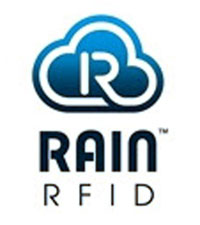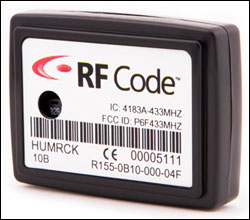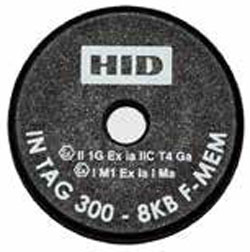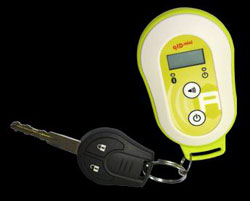The following are news announcements made during the past week by the following organizations:
RF Code, Quantum Data Systems;
HID Global;
CAS DataLoggers;
Farsens; and
RAIN Alliance.
Hong Kong Power Co. Deploys RF Code’s Sensor Tags
RF Code and Quantum Data Systems (QDS), an IT solutions distributor headquartered in Hong Kong, have announced that a major Hong Kong power company has been using RF Code’s environmental and power-management solutions in its data centers. As result, RF Code reports, the power company has reduced downtime, manpower and overtime associated with four primary computer rooms. According to RF Code, the power company in question provides electrical service to more than half a million homes and businesses in the region. Several months ago, it contacted QDS seeking a solution that would help it reduce the amount of energy—and, thus, the amount of money it was spending—to cool its data center.
The power company is using 400 of RF Code’s battery-powered 433 MHz RFID sensor tags at its facilities to monitor and control all modes of power generation, transmission and distribution. RF Code’s environmental monitoring infrastructure is integrated with QDS’s DC Insight data center monitoring solution, and includes RF Code’s readers and compact, peel-and-stick sensors. The RF Code sensor network provides a continuous flow of environmental data to DC Insight, which immediately alerts the power company’s management team if it detects any hazardous changes to the environment.
The solution is helping the company proactively addresses issues in real time, according to RF Code. The company first installed a proof-of-concept (POC) deployment consisting of 40 RF Code temperature sensors paired with readers and software for a single remote computer room. After only the first few months of deployment, RF Code reports, the solution had alerted operational staff about condensation accumulating beneath the raised floor, steadily rising temperatures due to a variable refrigerant volume/variable refrigerant flow (VRF/VRV) failure, as well as hot and cold spots in equipment racks and computer rooms, caused by improper or inadequate air circulation.
The RFID-based solution replaced a building management system (BMS) the power company had implemented that featured basic environmental monitoring capabilities and provided information regarding temperature and humidity levels surrounding server racks. However, RF Code notes, the power company found that the BMS could not easily scale with its growing IT environment, or integrate with its existing back-end systems, that it was becoming too costly, and that it lacked any method of notifying personnel when the temperature, humidity or other environmental metrics fell outside acceptable ranges, or when other system failures occurred. This, RF Code adds, prevented the Hong Kong utility from taking a proactive approach to disaster prevention.
Now that the power company can reliably monitor its four primary computer rooms with the integrated solution from RF Code and QDS, it plans to expand the solution to more than 30 network equipment rooms located throughout its facilities. What’s more, RF Code reports, the company is also considering leveraging the existing RF Code reader infrastructure to include RF Code’s asset-management solutions to track the 1,500 assets that reside on its sites.
HID Global Debuts 8 KB FRAM RFID Transponder
HID Global has debuted its IN Tag 300 8KB, a passive high-frequency (HF) transponder with eight kilobytes of ferroelectric random access memory (FRAM) technology, provided by Fujitsu Semiconductor. FRAM chips provide fast write speeds and high memory capacity, according to HID Global, and the technology accelerates data access close to the maximum speed for HF tags; endures billions of read and write cycles; and withstands gamma radiation up to 50 KGray to survive, for example, medical sterilization processes. FRAM enables write cycles up to 33,000 times faster than with the EEPROM memory conventionally used for RFID tags, HID Global explains, and also allows approximately 1,000,000 times more write cycles than EEPROM, making it suitable for applications with fast-moving targets and frequent write accesses, such as those involving sensors or data-loggers.
According to HID Global, the IN Tag 300 8KB is suitable for tagging medical supplies and equipment subject to sterilization via autoclave, gamma ray and X-ray irradiation, as well as for industrial applications in harsh environments, such as manufacturing lines. The tag complies with the ISO 15693 standard and protects data integrity even under radiation exposure. It is ATEX-certified for use in explosive environments, can withstand peak temperatures of up to 285 degrees Fahrenheit (140 degrees Celsius), and is both UL94-HB flame-resistant and food-contact compatible.
CAS DataLoggers Intros RFID Cold Chain Solutions
CAS DataLoggers has announced its first RFID products in its portfolio of data-logging equipment. The company’s lineup now includes ultrahigh-frequency (UHF) RFID technology from CAEN RFID. CAEN RFID Easy2log Data Loggers, compatible with the EPC Gen 2 and ISO 18000-6C standards, are designed to provide visibility of the overall supply chain, according to CAS DataLoggers. The RFID-enabled sensor tags and readers can be used to monitor perishable products, and can be wirelessly configured. Data can be collected from multiple loggers simultaneously, even at long distance.
CAS DataLoggers is now offering CAEN RFID’s Easy2log RT0005 UHF RFID tags (see RFID News Roundup: CAEN RFID Releases New RFID Temperature Logger. The tag includes a sensor for measuring the temperatures of sensitive products during transportation and/or storage, such as biopharmaceuticals, fresh or frozen food, and chemicals. The RT0005 tag can be started either by pressing a button or via standard RFID commands. It can calculate mean kinetic temperature and configurable remaining shelf life time, CAS DataLogger reports, as well as generate alarms in the event that these values exceed user-defined thresholds. An external probe model is also available for both models of data loggers, to measure temperatures even within a shielded box through which the RFID field cannot pass (see RFID News Roundup: CAEN RFID Announces RFID Temperature Logger With External Probe). CAS DataLogger is also offering CAEN’s Easy2log A927Z temperature logger, which offers 16 kilobytes of memory—sufficient to record 8,000 temperature readings, according to the company.
The products also support integration with a Web portal that customers can access to track assets, time, location information and temperature history from shipment time to the checkpoint. Available for free download, the Easy2log software enables customers to configure, control and download data from the temperature tags. According to CAS DataLogger, a software development kit also is available that enables further customization.
CAS DataLogger’s RFID portfolio also includes the Slate UHF RFID desktop reader, a multi-regional UHF RFID interrogator with an integrated antenna for short- to medium-range applications. Powered and controlled directly by a USB cable, the Slate can read EPC Class 1 Gen 2 UHF RFID tags in an easy desktop environment. The company also offers a complete kit containing the Slate reader, temperature tags and labels. In addition, CAS DataLogger offers portable UHF RFID readers that are designed for use in indoor or outdoor applications and can be paired with a smartphone or a tablet. The Wearable Bluetooth RFID Reader, usable with the Easy2read family, is a UHF multi-regional RFID reader with an integrated antenna for short- to medium-range applications, and is compliant with the ISO 18000-6C/EPC C1G2 standards. The reader hosts an internal rechargeable battery and can operate either in wired mode, using a USB cable or in wireless mode, via the Bluetooth interface. The reader is compatible with Microsoft Windows XP/7, Windows CE/Mobile, Android and Apple iOS operating systems.
The Keyfob Bluetooth UHF RFID Reader interrogates data from the Easy2read product family and is compliant with the ISO 18000-6C/EPC C1G2 standards for UHF RFID. This handheld device has an integrated antenna suited for short- to medium-range applications, supports Bluetooth, and is compatible with Windows XP/7, Windows CE/Mobile, Android, iPhone and iPad. The HID version supports native keyboard emulation, allowing direct interaction with legacy applications, office automation SW or any other generic solution requiring manual input.
Farsens Unveils Battery-Free UHF RF Field Detector for Assessing RFID Systems
Farsens, a Spanish developer of passive RFID sensor tags, has introduced the Photon, a passive ultrahigh-frequency (UHF) tag with a sensor for detecting a UHF RF field. Whenever the Photon tag is close to an RF field source, it will harvest the energy from the RF field and illuminate its built-in LED indicator light. The detection range is up to 3 meters (9.8 feet) for UHF RFID readers. The stronger the RF field in a specific point and orientation, the brighter the LED will illuminate, according to Farsens. The tag consists of Farsens’ proprietary ANDY100FE IC and a green LED. The tag is built in a PCB format and available in a variety of sizes, and can be encapsulated in an IP67 or IP68 casing, enabling it to be used in harsh environments.
Designed to help assess the status of an aging RFID implementation, the Photon can be used to help determine how well an RFID system is performing, Farsens reports. This is important, the company notes, because RFID readers and reader antennas deployed several years ago may not perform correctly now. RF field detectors can also be used to signal activities to users. Entering a specific area may require a certain set of procedures from a user, and in order to make that user aware that he or she has entered the area, a flashing LED can act as a visual indicator. The Photon could alert a user, for example, about a specific task to perform at a particular location.
RAIN Alliance Grows Membership, Prepares for First Meeting
Since its founding in April 2014, RAIN RFID has added 18 companies as members. The organization was established by Impinj, Intel, Google and Smartrac to promote the adoption of EPC ultrahigh-frequency (UHF) RFID (see Technology Companies Create RAIN to Promote EPC UHF RFID Adoption).

The membership roster now includes Aczept Technology Co., CAEN RFID, CISC Semiconductors, eAgile, Evanhoe & Associates, FEIG Electronics, Hanni IT Co., Korea Testing Laboratory, MEPS Real-Time, Nedap, Omni-ID, RAID Labs, Terso Solutions, U Grok It, Vanguard ID Systems, Voyantic, Weldon, Williams & Lick, and Zebra Technologies. In a prepared statement announcing FEIG Electronics as RAIN’s newest member, Frithjof Walk, FEIG Electronics’ president, said that the RAIN Alliance provides “an opportunity to fulfill the need for an authoritative, international cooperation among leading innovators to further advance the Internet of Things ecosystem.”
According to Steve Halliday, RAIN’s president, that number is likely to grow. “I am talking to a lot of other companies who are all seeing the value of the alliance,” he says. “Many of them have paperwork in process to join us.”
In addition to the new members, the industry association is gearing up for its first RAIN Face to Face Meeting, which will be held on Sept. 9., in the Washington, D.C., metro area, following the AIM Summit 2014 on Sept. 8, at Hyatt Regency Crystal City. The RAIN Summit is free to members, and will include a morning of informational presentations. This session will also be open to non-members for a fee. After lunch, the meeting will be open to members only, and work will commence on the various topics of the association.





